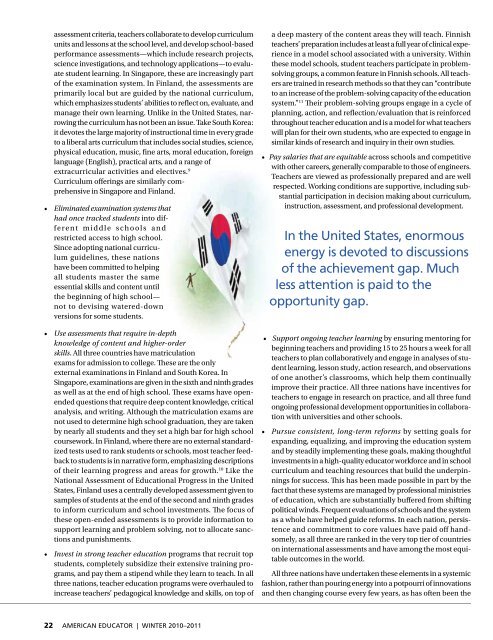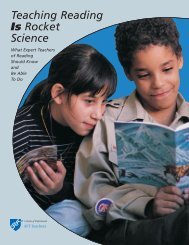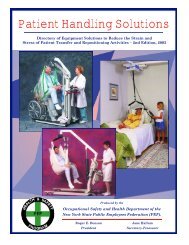American Educator, Winter 2010-11, Vol. 34, No. 4, AFT
American Educator, Winter 2010-11, Vol. 34, No. 4, AFT
American Educator, Winter 2010-11, Vol. 34, No. 4, AFT
Create successful ePaper yourself
Turn your PDF publications into a flip-book with our unique Google optimized e-Paper software.
assessment criteria, teachers collaborate to develop curriculum<br />
units and lessons at the school level, and develop school-based<br />
performance assessments—which include research projects,<br />
science investigations, and technology applications—to evaluate<br />
student learning. In Singapore, these are increasingly part<br />
of the examination system. In Finland, the assessments are<br />
primarily local but are guided by the national curriculum,<br />
which emphasizes students’ abilities to refl ect on, evaluate, and<br />
manage their own learning. Unlike in the United States, narrowing<br />
the curriculum has not been an issue. Take South Korea:<br />
it devotes the large majority of instructional time in every grade<br />
to a liberal arts curriculum that includes social studies, science,<br />
physical education, music, fi ne arts, moral education, foreign<br />
language (English), practical arts, and a range of<br />
extracurricular activities and electives. 9<br />
Curriculum off erings are similarly comprehensive<br />
in Singapore and Finland.<br />
• Eliminated examination systems that<br />
had once tracked students into different<br />
middle schools and<br />
restricted access to high school.<br />
Since adopting national curriculum<br />
guidelines, these nations<br />
have been committed to helping<br />
all students master the same<br />
essential skills and content until<br />
the beginning of high school—<br />
not to devising watered-down<br />
versions for some students.<br />
• Use assessments that require in-depth<br />
knowledge of content and higher-order<br />
skills. All three countries have matriculation<br />
exams for admission to college. Th ese are the only<br />
external examinations in Finland and South Korea. In<br />
Singapore, examinations are given in the sixth and ninth grades<br />
as well as at the end of high school. Th ese exams have openended<br />
questions that require deep content knowledge, critical<br />
analysis, and writing. Although the matriculation exams are<br />
not used to determine high school graduation, they are taken<br />
by nearly all students and they set a high bar for high school<br />
coursework. In Finland, where there are no external standardized<br />
tests used to rank students or schools, most teacher feedback<br />
to students is in narrative form, emphasizing descriptions<br />
of their learning progress and areas for growth. 10 Like the<br />
National Assessment of Educational Progress in the United<br />
States, Finland uses a centrally developed assessment given to<br />
samples of students at the end of the second and ninth grades<br />
to inform curriculum and school investments. Th e focus of<br />
these open-ended assessments is to provide information to<br />
support learning and problem solving, not to allocate sanctions<br />
and punishments.<br />
• Invest in strong teacher education programs that recruit top<br />
students, completely subsidize their extensive training programs,<br />
and pay them a stipend while they learn to teach. In all<br />
three nations, teacher education programs were overhauled to<br />
increase teachers’ pedagogical knowledge and skills, on top of<br />
22 AMERICAN EDUCATOR | WINTER <strong>2010</strong>–20<strong>11</strong><br />
a deep mastery of the content areas they will teach. Finnish<br />
teachers’ preparation includes at least a full year of clinical experience<br />
in a model school associated with a university. Within<br />
these model schools, student teachers participate in problemsolving<br />
groups, a common feature in Finnish schools. All teachers<br />
are trained in research methods so that they can “contribute<br />
to an increase of the problem-solving capacity of the education<br />
system.” <strong>11</strong> Th eir problem-solving groups engage in a cycle of<br />
planning, action, and refl ection/evaluation that is reinforced<br />
throughout teacher education and is a model for what teachers<br />
will plan for their own students, who are expected to engage in<br />
similar kinds of research and inquiry in their own studies.<br />
• Pay salaries that are equitable across schools and competitive<br />
with other careers, generally comparable to those of engineers.<br />
Teachers are viewed as professionally prepared and are well<br />
respected. Working conditions are supportive, including substantial<br />
participation in decision making about curriculum,<br />
instruction, assessment, and professional development.<br />
In the United States, enormous<br />
energy is devoted to discussions<br />
of the achievement gap. Much<br />
less attention is paid to the<br />
opportunity gap.<br />
• Support ongoing teacher learning by ensuring mentoring for<br />
beginning teachers and providing 15 to 25 hours a week for all<br />
teachers to plan collaboratively and engage in analyses of student<br />
learning, lesson study, action research, and observations<br />
of one another’s classrooms, which help them continually<br />
improve their practice. All three nations have incentives for<br />
teachers to engage in research on practice, and all three fund<br />
ongoing professional development opportunities in collaboration<br />
with universities and other schools.<br />
• Pursue consistent, long-term reforms by setting goals for<br />
expanding, equalizing, and improving the education system<br />
and by steadily implementing these goals, making thoughtful<br />
investments in a high-quality educator workforce and in school<br />
curriculum and teaching resources that build the underpinnings<br />
for success. Th is has been made possible in part by the<br />
fact that these systems are managed by professional ministries<br />
of education, which are substantially buff ered from shifting<br />
political winds. Frequent evaluations of schools and the system<br />
as a whole have helped guide reforms. In each nation, persistence<br />
and commitment to core values have paid off handsomely,<br />
as all three are ranked in the very top tier of countries<br />
on international assessments and have among the most equitable<br />
outcomes in the world.<br />
All three nations have undertaken these elements in a systemic<br />
fashion, rather than pouring energy into a potpourri of innovations<br />
and then changing course every few years, as has often been the





